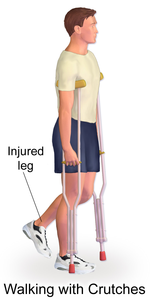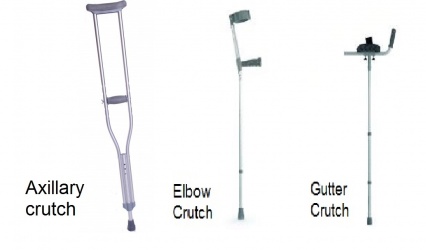Crutches
Original Editor - The Open Physio project. Top Contributors - Samrah khan, Kim Jackson, Ahmed Essam, Jess Bell, Rachael Lowe, Admin, Larisa Hoffman, Ammar Suhail, WikiSysop, Redisha Jakibanjar, Lucinda hampton, Karen Wilson, Claire Knott, Tolulope Adeniji, Robin Tacchetti, Jorge Rodríguez Palomino, Laura Ritchie and Naomi O'Reilly
Introduction[edit | edit source]
Crutches are a type of Walking Aids that serve to increase the size of an individuals Base of support. It transfers weight from the legs to the upper body and is often used by people who cannot use their legs to support their weight (ie short-term injuries to lifelong disabilities).
Crutch Type[edit | edit source]
There are three types of crutches; Axilla crutches, Elbow crutches and Gutter crutches.
Axilla or underarm crutches They should actually be positioned about 5 cm below the axilla with elbow flexed 15 degree approximately.[1] The design includes an axilla bar, a handpiece and double uprights joined distally by a single leg. They are adjustable in height, both the overall height and handgrip height can be adjusted (adjustable approximately 48 to 60 inches (12 to 153 cm)[2])
Forearm crutches (or lofstrand, elbow or canadian crutches). Thier design includes a single upright, a forearm cuff and a hand grip. The height of the forearm crutches are indicated from handgrip to the floor (adjustable from 29 to 35 inches or 74 to 89 cm).[2]
Gutter Crutches (or adjustable arthritic cruches, forearm support crutches) These are additional type of crutches, which is composed of padded forearm support made up of metal, an strap and adjustable hand piece with rubber ferrule. These crutches are used for patients who are on partial weight bearing like Rheumatoid disease.[1]
Measurement[edit | edit source]
It is essential that crutches are measured and adjusted to suit every patient they are given to. There are various methods to measure both the canes.
Walking pattern[edit | edit source]
There are several different walking patterns that an individual using crutches may use, including:
- 2 point :.the crutches and the fractured leg are one point and the uninvolved leg is the other point. The crutches and fractured limb are advanced as one unit, and the uninvolved weight-bearing limb is brought forward to the crutches as the second unit . this gait pattern is less stable as only two points are in contact with floor and good balance is needed to walk with 2 points crutch gait
- 3 point: this gait pattern is used when one side lower extremity (LE) is unable to bear weight (due to fracture, amputattion, joint replacement etc). It invloves three points contact with floor, the crutches serve as one point,the involved leg as the second point, and the uninvolved leg as the third point. Each crutch and the weight-bearing limb are advanced separately, with two of the three points maintaining contact with the floor at any given time .
- 4 point: this gait pattern is used when there's lack of coordination, poor balance and muscle weakness in both LE, as it provides slow and stable gait pattern with three points support.[1] [3]
- gait to : the fractured limb is advanced, and then the intact limb brought to the same position. When weight-bearing status is restricted to partial, toe-touch,or as tolerated, crutches or a walker are necessary and help the patient step to the fractured limb by pushing down with the upper extremities, thus transferring weight from the fractured limb to the assistive device.
- gait through: the intact leg is advanced,and then the fractured leg is advanced past it. With restricted weight bearing, crutches are used instead of the injured limb, and the patient steps past the crutches with the weight-bearing lower extremity; the gait assumes a two-point or three-point pattern.
Indications[edit | edit source]
The use of crutches may be indicated if a patient:
- Has lost the use of a limb (it is either injured or amputated).
- Is having problems with Balance and impaired strength.
See also[edit | edit source]
References[edit | edit source]
- ↑ 1.0 1.1 1.2 Gardiner DM. The Principles Of Exercise Therapy, 4th ed. india: CBS Publishers & Distributors; 2004.
- ↑ 2.0 2.1 O'Sullivan SB, Schmitz TJ, Fulk G. Physical rehabilitation. FA Davis; 2013 Jul 23.
- ↑ Dr Das P. Walking Crutches. http://www.physiotherapy-treatment.com/ (accessed 27 December 2016)








